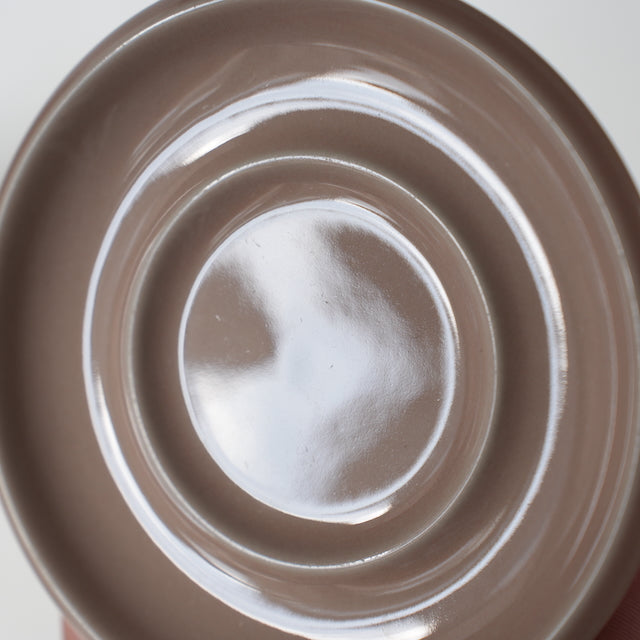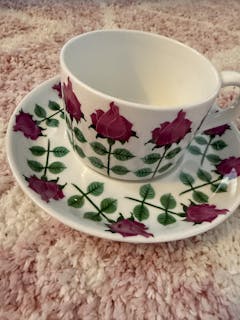ARABIA
ARABIA Koralli coffee cup and saucer
ARABIA Koralli coffee cup and saucer
Couldn't load pickup availability
This is the legendary masterpiece, Korali, from ARABIA, Finland's leading ceramic manufacturer. The series name Korali means "coral reef" and features dancing pink coral resembling cherry blossom petals. The design was done by Raija Uosikkinen, known for Emilia and Kalevala. Uosikkinen retired from ARABIA in 1986, so this work, designed in 1983, was the last work of her career.
The designer of the Coralli shape was Ulla Procoppe, who is famous for Ruska and Valencia. Coralli was modeled on the shape of the "S model" of the smash hit Ruska, designed in 1960. The S model is the collective name given to the basic form of the series of tableware used in Ruska, including cups, plates, and pots.
Since the introduction of the S model, many Arabia products have been produced using the same shape as the Ruska S model while changing the surface decoration. Ulla Prokoppe died in 1968, so the Corali series released in 1983 shows that the S model designed by Ulla Prokoppe was highly regarded for nearly 20 years after his death. The S model is also used in the Cosmos, Fractus, Flora and other tableware series. As the same shape was still used, it was called the S-Model, an acronym of Sama (which means "same" in Finnish).
Coralie comes in four different sizes: demitasse, coffee, mug, and tea. This product is a coffee cup that is slightly larger than a demitasse cup, and is characterized by its longer vertical shape. Also, the shape of the handle is different from that of a mug, but the size is the same.
Uosikkinen's pink coral design depicts coral that is commonly found in the Asia-Pacific region, such as Japan, the Philippines, and Hawaii. A characteristic of Scandinavian tableware is that it often incorporates a spring-like gaiety into its designs, which is in contrast to the long winters of the region, and Coralli's work is a good example of this characteristic.
This product was released during the economic recession of the 1980s, when Arabia reduced production, making it a rare item today. In particular, the same S model was produced in smaller numbers than those produced in the 1960s and 1970s, and it is currently traded at a high price on the market .
This is why Ruskas from the 1960s are still relatively inexpensive, while newer Corallis of the same shape are very expensive. Corallis are very popular for their cute design, and the larger the cup size, the rarer they are in the vintage market.
■ Detailed specifications
Manufacturer: ARABIA / ArabiaForm Designer: Ulla Procope / Ulla ProcopePattern Designer: Raija Uosikkinen / Raija UosikkinenSeries: Koralli / KoralliYear: 1983-1987Country of Origin: FinlandCondition: There is a chip on the back of the saucer. There is no problem with use, and the cup is in good condition.
■Size
Diameter 7cm Height 7.8cm Saucer diameter 12.5cm
Cup capacity: approx. 150ml

















Ulla Procope

Ulla Procope (1921-1968)
Born in Helsinki. In 1948 , he graduated from the Faculty of Art and Design at Aalto University in Helsinki and joined Arabia Company. After that, he was in charge of design in the production department for 20 years, creating the Ruska series in 1960 and the Valencia series in 1961 . Ruska became the longest-running and most sold flagship product of Arabia's products, and the form of Ruska was called the S model , which became the prototype model for subsequent ARABIA tableware. Valencia is the last hand-painted ARABIA product. After suffering from cancer and retiring from active duty, Procope moved to Spain's Canary Islands, where he died at the age of 47 .
Raija Uosikkinen

Raija Uosikkinen (1923-2004)
Originally from Holoran, a town in southern Finland. Graduated from Aalto University's Faculty of Fine Arts in 1947 and joined Arabia. He worked as an exclusive designer for Arabia for 40 years until 1986, and was responsible for the designs of the Emilia series and Kalevala ear plates. He often collaborated with Kai Franck, with Kai Franck generally providing the form of the product and Uosikkinen providing the decorative design.
Even after Laija Uosikkinen retired from ARABIA in 1986 , he continued to live in a house right next to his company and happily invited the company's current designers and students from Aalto University to his home, providing friendly hospitality while also serving as a mentor to future generations. He is said to have provided guidance. His most famous work, the Emilia series, is said to express his longing for life in the distant United States. After World War II, Finland was never a rich country due to a series of periods of poverty, and the longing for richness during these poor and difficult times is the background behind the creation of this masterpiece.
Collapsible content
Accepted payment methods
- Various credit cards
- Apple pay, Google Pay, Paypal
- Convenience store settlement
- Bank transfer
- Smartphone payment (QR code payment)
Arrive the day after shipping
Our shipping location is Shiga Prefecture. Domestic areas, excluding Hokkaido, Okinawa Prefecture, remote islands, and parts of Tohoku, will arrive the day after the shipping notification (except in the case of bad weather, etc.).
vintage rating
See below for more information on rating conditions using stars.
About the size of the product
Product photos are close-ups so that you can see the condition well. Therefore, the actual product may appear smaller. The wooden spoon is for size comparison, not an accessory, and is 13 cm long.
about shipping cost
The shipping fee is a flat rate of 900 yen ( free shipping for purchases over 10,000 yen ).
*Shipping fee for Hokkaido and Okinawa is 1,400 yen (free shipping for purchases over 13,000 yen).
International Shipping
We are offering international shipping to over 100 locations. Enjoy free shipping when you spend 200,000 JPY or more.






















